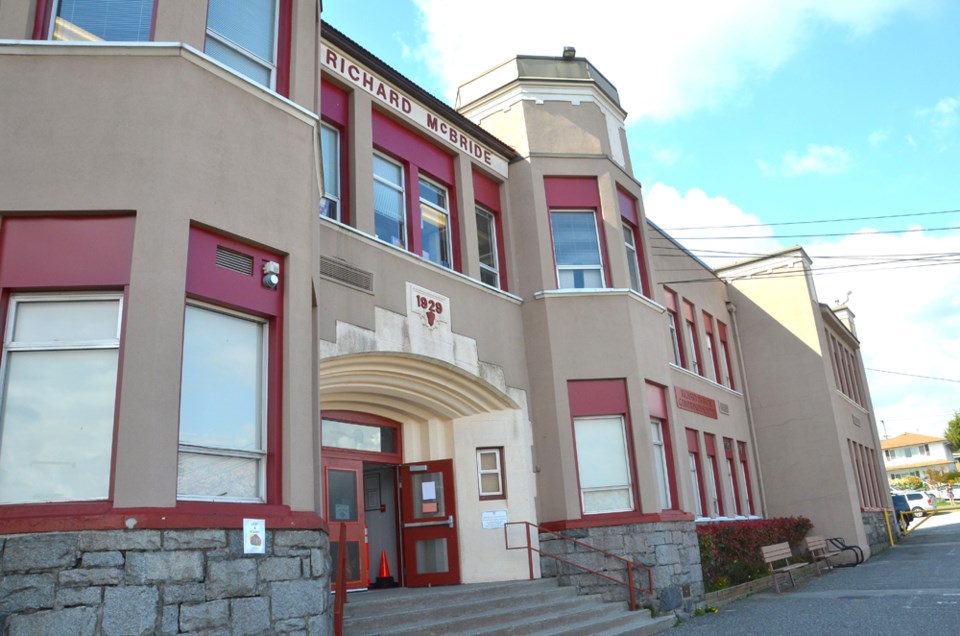B.C.’s Ministry of Education is still assessing whether the aging Richard McBride Elementary School should be replaced or retrofitted, according to New Westminster MLA Judy Darcy.
The Sapperton-area school was built in 1929 and has the highest seismic rating – H1. That means it’s the “most vulnerable” and has the highest risk of widespread damage or structural failure. It wouldn’t be reparable after an earthquake.
McBride is one of 181 schools across B.C. that still need seismic upgrades.
According to the province’s latest update on its seismic mitigation program, McBride remains in the “business case development stage,” while 12 other schools have proceeded to construction.
Four of those 12 schools, however, are H3s and have a lower rating.
Asked why a H3-ranked school would take priority over a H1-ranked school, Darcy said it’s because those projects are smaller, can be finished quickly and there’s no question that what’s needed is seismic upgrading.
In McBride’s case, the project is so “significant” that it needs to be approved by the Treasury Board.
“The information that I have is that one of the issues that’s under review is whether given the cost involved for this school, what makes the most the sense. Is it seismically upgrading it or is it replacing it?” said Darcy.
The MLA couldn’t give any estimates on what it would cost for either option.
Darcy noted once a capital project – whether it’s a school or a hospital – meets a certain threshold, it needs the Treasury Board’s approval.
“Our government is committed to making schools in B.C. safer for students, and we are actively looking at schools in New Westminster,” she said, adding the NDP has committed $3.9 million for seismic upgrading at F.W. Howay Elementary and $106 million for the replacement of NWSS.
“There are far too many schools, including Richard McBride, that are left to be seismically upgraded because only 164 out of 346 in the province have been completed,” she told the Record. “That’s the legacy that we’re dealing with from the previous government. We’ve been in office two months now, so we’re working to change this and to fast track seismic projects.”
Jen Arbo, vice-chair of the McBride parent advisory council (PAC), said she gets a lot of questions from parents about the fate of the school.
“Especially some of the new parents. They’ve just enrolled their kids in kindergarten or what have you and they’re very excited, and they recognized McBride is an old school, and then they maybe do a little bit of googling, and the next thing you know, they find out the status of McBride is an H1-rated school, so then they ask the PAC what’s going on.”
Arbo met with Darcy to share her concerns, and said she left “satisfied.”
“Judy is approaching this collaboratively and as transparently as possible. There are constraints, in that one, it is a new government …Judy is going to do what she can with her particular position and she’s going to help us as much as possible,” said Arbo.
She added she’d like to see more transparency when it comes to keeping parents in the loop about where the project is at in the process.
“You can bet the PAC is watching this issue closely,” said Arbo.
Fast facts: What is the Treasury Board?
The Treasury Board is responsible for developing and reviewing the provincial government’s economic and fiscal policies.
Under the Financial Administration Act, the Treasury Board acts as a committee of the executive council in matters related to the following: accounting policies and practices; government management practices and systems; government financial management and control, including expenditures and assets; evaluation of government programs as to economy, efficiency and effectiveness; government personnel management and other matters.
The Treasury Board has the power to require government bodies to have its approval before making commitments to capital expenditures. It also can establish requirements for capital plans, business cases, requests for approval, tendering and procurement documents, progress reports, completion reports and post-expenditure reports.
The Treasury Board has four branches: deputy secretary to treasury board, economic forecasting and analysis branch, fiscal planning and estimates, and performance and budgeting office.
Finance Minister Carole James sits as chair.



